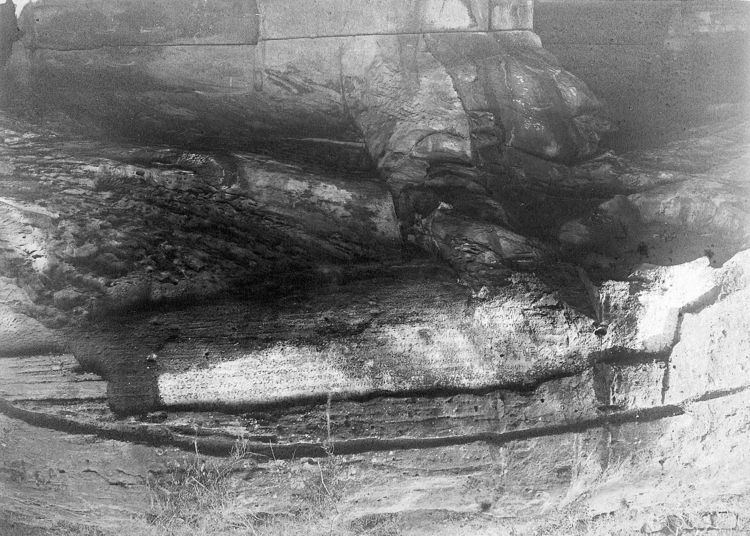Name Hathigumpha inscription | ||
 | ||
Popular Videos - Udayagiri and Khandagiri Caves & Hathigumpha inscription
The Hathigumpha Inscription ("Elephant Cave" inscription), from Udayagiri, near Bhubaneswar in Odisha, was inscribed by Kharavela, the then Emperor of Kalinga in India, during 2nd century BCE. The Hathigumpha Inscription consists of seventeen lines in a Central-Western form of Prakrit incised in a deep-cut Brahmi script on the overhanging brow of a natural cavern called Hathigumpha in the southern side of the Udayagiri hill, near Bhubaneswar in Odisha. It faces straight towards the Rock Edicts of Ashoka at Dhauli, situated at a distance of about six miles.
Contents
- Popular Videos Udayagiri and Khandagiri Caves Hathigumpha inscription
- Background
- Salient features
- Source
- References
The inscription is written in a type which is considered as one of the most archaic forms of the Kalinga alphabet, also suggesting a date around 150 BCE.
The inscription is dated 13th year of Kharavela's reign, which has been dated variously by scholars from the 2nd century BCE to the 1st century CE.
Background
Hathigumpha Inscription at Udayagiri Caves is the main source of information about Kalinga ruler Kharavela. This inscription, consisting of seventeen lines has been incised in deep cut Brahmi script of the 1st century BCE, on the overhanging brow of a natural cavern called Hathigumpha, in the southern side of the Udayagiri hill. It faces straight towards the Rock Edicts of Ashoka at Dhauli situated at a distance of about six miles. It was introduced to the Western world by A. Stirling in 1820, who published an eye copy of it in Asiatic Researches, XV, as well as in his book An Account, Geographical, Statistical and Historical of Orissa or Cuttack and by James Prinsep, who deciphered the inscription. Prinsep's reading along with the facsimile prepared by Kittoe was Published in the Journal of the Asiatic Society of Bengal, VI (1837), where he erroneously attributed this inscription to a king named Aira. Towards the end of 1871, a plaster-cast of the inscription was prepared by H. Locke, which is now preserved in the Indian Museum, Calcutta. Alexander Cunningham published this inscription in 1877 in the Corpus Inscriptionum Indicarum Vol. I, and in 1880 R.L. Mitra published a slightly modified version in his Antiquities of Orissa, Vol. II.
Bhagwan Lal Indraji is credited with the first authentic reading, which he presented before the Sixth International Congress of Orientalists, 1885. It is to be noted here that, Pandit Indraji was the first scholar to declare that the king eulogised in the Hathigumpha inscription was named Kharavela. It is a fact that there is a large number of lacuna in the inscription, which obstruct its correct reading and because of its mutilated condition has given rise to unnecessary controversies.
The inscription mainly mentions the various conquests of this king, starting with his fight against the Satavahana king Satakarni:
"And in the second year (he), disregarding Satakamini, dispatches to the western regions an army strong in cavalry, elephants, infantry (nara) and chariots (ratha) and by that army having reached the Kanha-bemna, he throws the city of the Musikas into consternation." Epigraphia Indica, Vol. XXSalient features
The Hathigumpha inscription starts with a version of the auspicious Jain Namokar Mantra: नमो अरहंतानं [॥] णमो सवसिधानं [॥] for in Jainism.
The Hathigumpha Inscription mentions that:
"Then in the eighth year, (Kharavela) with a large army having sacked Goradhagiri causes pressure on Rajagaha (Rajagriha). On account of the loud report of this act of valour, the Yavana (Greek) King Dimi[ta] retreated to Mathura having extricated his demoralized army."
The name of the Yavana king is not clear, but it contains three letters, and the middle letter can be read as ma or mi. R. D. Banerji and K.P. Jayaswal read the name of the Yavana king as "Dimita", and identify him with Demetrius I of Bactria. However, according to Ramaprasad Chanda, this identification results in "chronological impossibilities". According to Sailendra Nath Sen, the Yavana ruler was certainly not Demerius; he might have been a later Indo-Greek ruler of eastern Punjab. Numismatist P.L. Gupta interprets the name as "Vimaka", and identifies him with Vima Kadphises. However, Vima Kadphises was a Kushana, not Yavana, king. It is otherwise unknown for a Kushan emperor to have been referred to as a Yavana, and for Vima Kadphises to be referred to as "Vimaka". Also, there are palaeographic problems with dating the Hathigumpha inscription to Vima Kadphises' period.